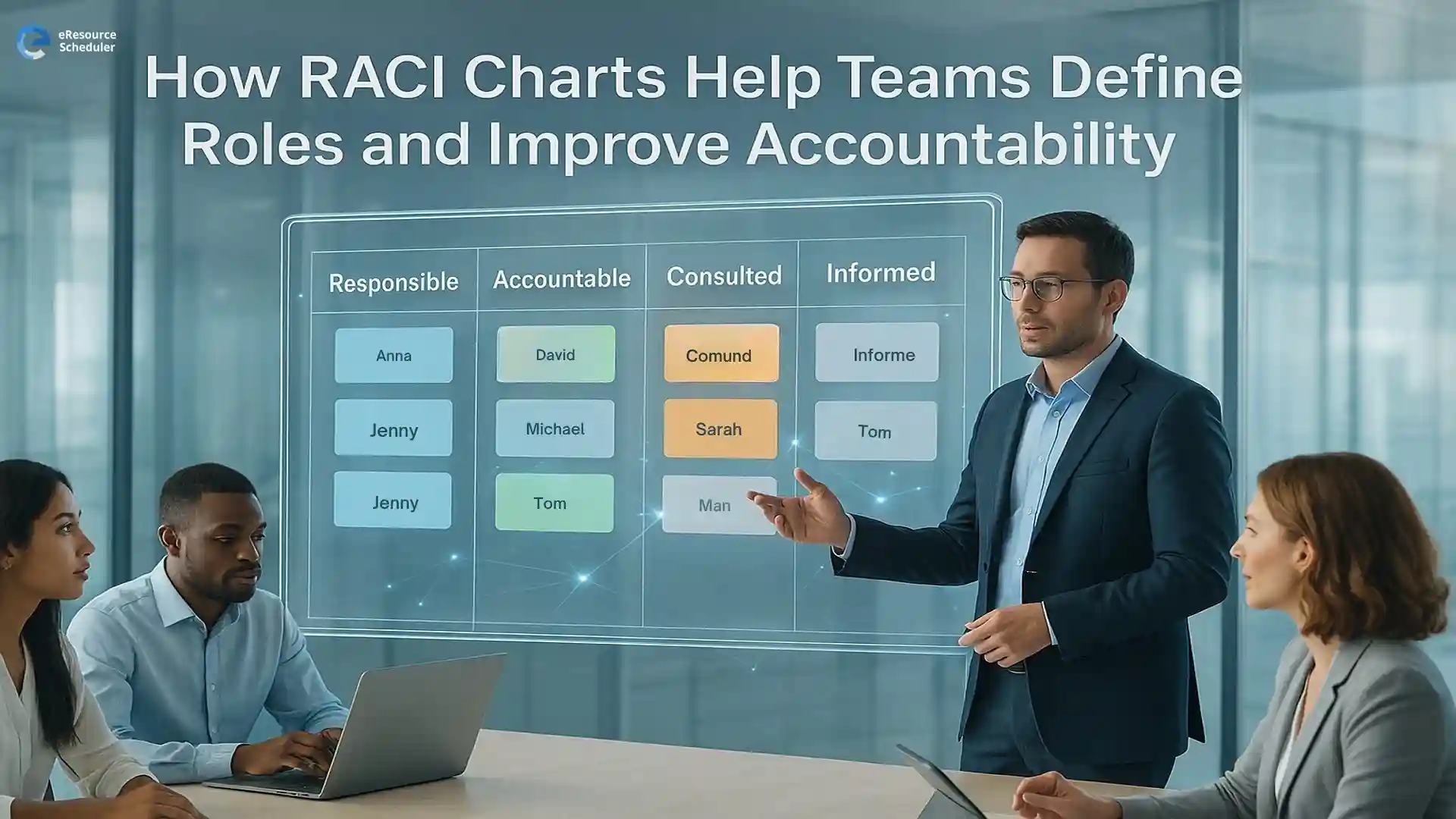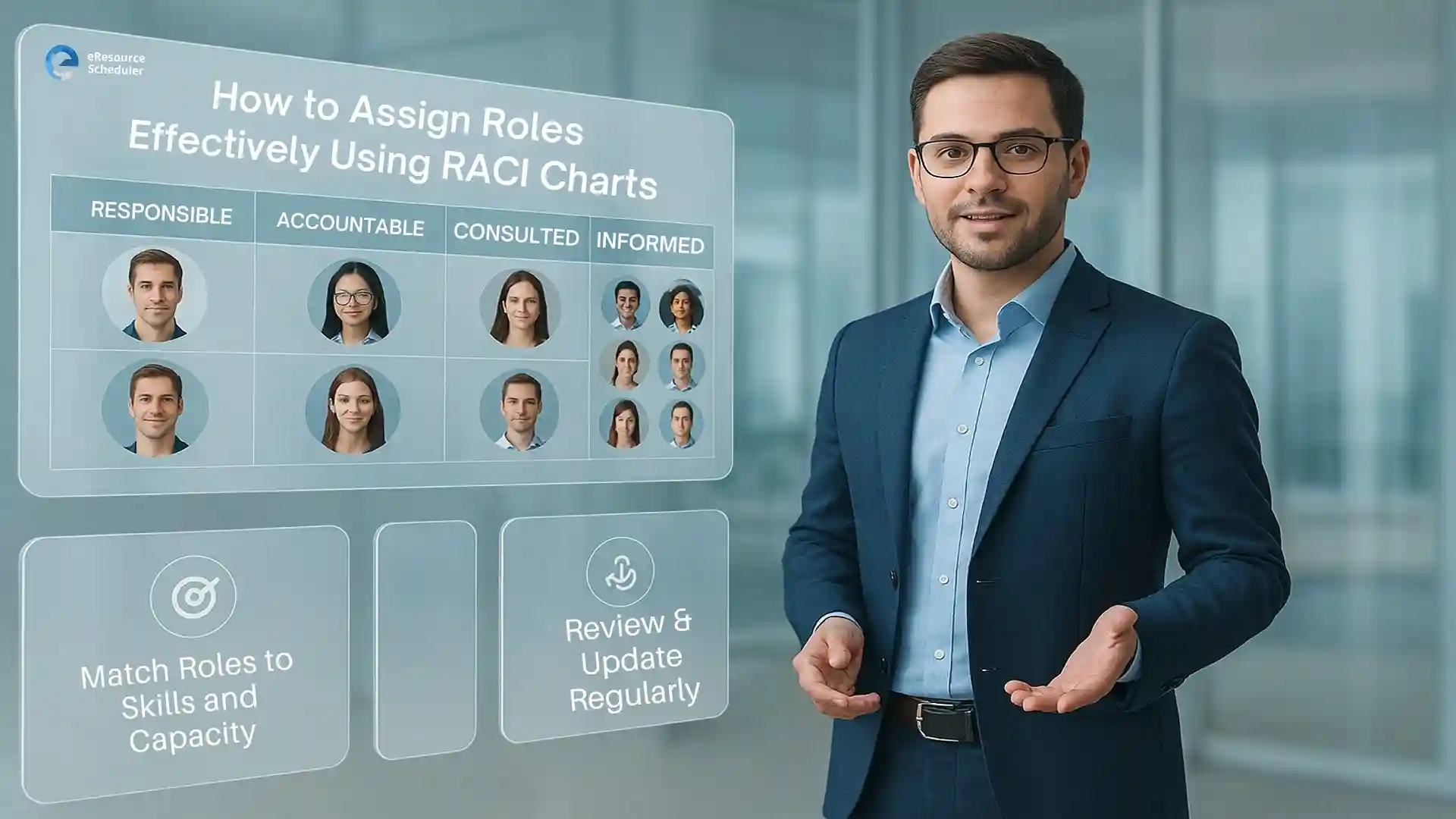
Every successful project depends on clarity, who does what, who approves decisions, and who stays informed. Without that clarity, teams lose time, duplicate efforts, and struggle to stay aligned. That’s where RACI charts come in.
A RACI chart is a simple, visual way to define who’s Responsible, Accountable, Consulted, and Informed for each task. It ensures that work is distributed fairly and that no role slips through the cracks. When used alongside a modern resource management software, RACI charts become even more powerful by providing real-time visibility into workloads, roles, and progress.
RACI charts bring structure to collaboration. They define every team member’s role so that responsibilities do not overlap, decisions stay clear, and execution becomes smoother. In project and resource management, this clarity is not optional. It is the foundation of efficiency.
Unclear roles are one of the main reasons projects fall behind schedule. According to a 2025 Deloitte report, nearly 47 percent of project delays stem from poorly defined ownership. A RACI chart eliminates that confusion by assigning clear accountability for each deliverable. When every team member knows their R and A, work flows faster and communication improves.
Teams that work across departments or locations rely on strong coordination. With RACI charts, communication lines are visible from the beginning. Everyone knows who to consult before making changes, which prevents duplicate efforts and decision bottlenecks. It is a simple structure that replaces endless meetings with proactive teamwork.
Accountability strengthens performance. Since every task in a RACI chart has one clear owner, it becomes easier to track progress and ensure timely completion. Teams can also compare assigned roles with actual workload using resource capacity planning insights to maintain balance and avoid overallocation. This connection between defined roles and workload data creates a culture of responsibility that scales across departments.
Building a RACI chart is a simple yet structured process. It requires thoughtful planning, clear communication, and input from everyone involved. Follow these steps to create one that actually works for your team.
Start by listing every major task, milestone, and deliverable in your project. Break them down into smaller, manageable parts so that each can have a specific owner. This list forms the foundation of your RACI chart.
For large or complex projects, grouping tasks by phase or department can make the process smoother.
Next, identify the roles that will be involved. These do not have to match job titles. Instead, focus on what each person contributes. For instance, instead of “Marketing Manager,” you might use “Content Approver.” Keep your list role-based, not name-based, to maintain clarity.
Common roles include project managers, team leads, specialists, and external stakeholders.
Now assign who will be Responsible, Accountable, Consulted, and Informed for each task.
Responsible: The person or group doing the actual work.
Accountable: The one answerable for the outcome. Only one person should hold this role per task.
Consulted: People who provide feedback or input before decisions are made.
Informed: Those who need updates on progress but are not part of decision making.
When assigning these roles, ensure that no one person appears under too many Rs or As. That may indicate an uneven workload or lack of balance in the team.
Once the chart is built, review it with the full team. Ask whether the roles feel fair and realistic. Encourage open discussion so everyone agrees on their responsibilities.
You can also compare assigned responsibilities against actual work data using project timesheets to ensure your chart reflects real capacity and effort. Timesheet insights show how much time is truly being spent on each task, helping leaders fine-tune ownership and improve accuracy in future projects.
Creating and maintaining RACI charts manually can be time-consuming. Modern tools allow teams to visualize roles and workloads within a shared dashboard, making updates faster and collaboration easier. This digital approach helps teams stay aligned even as projects evolve.

A RACI chart only works when roles are assigned thoughtfully. Each letter in the model represents a specific responsibility: Responsible, Accountable, Consulted, and Informed. These designations must reflect real capacity, not assumptions. Assigning roles carefully ensures that projects move forward smoothly and workloads stay balanced.
Assign responsibilities based on each person’s skills, expertise, and availability. Someone may be skilled yet already managing several critical tasks, which makes them unsuitable for more assignments. The goal is to distribute work evenly so that no one feels overwhelmed. Matching skills with available time helps maintain steady performance across the team.
When several people believe they are accountable for the same task, confusion replaces collaboration. Each task should have only one person listed as Accountable. Others can be included as Consulted or Informed if they contribute feedback or need updates. Clear ownership prevents delays and keeps decision making efficient.
Teams evolve, projects expand, and new challenges appear. A RACI chart that was accurate months ago may no longer reflect the present situation. Review it at regular intervals and update it whenever roles or priorities change. Consistent reviews ensure your chart stays relevant and continues to support smooth teamwork.
Even though RACI charts are simple in structure, they are often misunderstood or misused. Avoiding these common mistakes helps teams get real value from the framework instead of turning it into another static document.
The purpose of a RACI chart is to create clarity. When too many roles or tasks are added, the chart becomes confusing and loses impact. Keep it simple. Focus on key deliverables and decision points rather than every minor activity. A clear and concise chart is easier to use and maintain.
A RACI chart should never be created in isolation. Team members often have a better understanding of what actually happens in daily operations. Failing to involve them leads to roles that look good on paper but do not work in practice. Invite feedback from those directly responsible for delivery and make adjustments together.
A RACI chart should evolve along with the project. When it is treated as a one-time document, it quickly becomes outdated. The best approach is to review it periodically during project meetings and adjust roles as timelines or priorities change. This keeps accountability fresh and aligned with current goals.
Many teams forget to review the final version with everyone involved. Without that shared understanding, even the best chart can fail. Always validate it in a group setting so that every person agrees on their role and expectations. A short review session now can prevent weeks of confusion later.
A well-built RACI chart is more than a tool. It is a mindset that brings order, accountability, and confidence to every project. When everyone understands their role, projects move faster, communication improves, and decision making becomes easier.
The RACI framework creates structure where there was once confusion. It helps teams align responsibilities, track ownership, and ensure nothing falls through the cracks. Whether your team is remote or in the office, using RACI consistently can turn project management from reactive to strategic.
If you want to see how role clarity supports smoother execution, schedule a personalized product demo and experience it firsthand.
1. What is a RACI chart?
A RACI chart is a project management tool that outlines who is Responsible, Accountable, Consulted, and Informed for each task. It brings structure to teamwork by clarifying roles, preventing overlap, and ensuring everyone understands their contribution to the project’s success.
2. Why use a RACI chart?
Teams use RACI charts to create transparency in projects. It helps assign clear ownership, reduce confusion, and improve collaboration. When each role is defined from the start, communication becomes easier and tasks get completed more efficiently.
3. Who is accountable in a RACI chart?
The accountable person is the one who owns the final outcome of a task. They ensure that responsibilities are met, deadlines are respected, and approvals are completed. Only one person should be accountable for each task to maintain clear authority.
4. What is the difference between responsible and accountable?
Being responsible means doing the actual work, while being accountable means owning the result. Several people can share responsibility, but accountability belongs to one individual who signs off on the outcome and ensures completion.
5. Can two people be accountable in RACI?
No. Each task must have a single accountable person. When more than one person shares accountability, decisions become unclear and progress slows. Limiting accountability to one individual keeps teams aligned and projects on track.
Plan Smarter. Schedule Faster.
Join thousands already using eResource Scheduler to align teams, time, and tasks seamlessly.